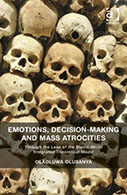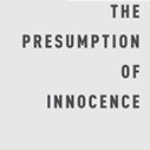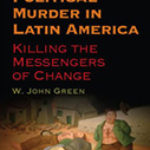Emotions, Decision-Making and Mass Atrocities: Through the Lens of the Macro-Micro Integrated Theoretical Model

Author: Olaoluwa Olusanya
Publisher: Farnham, Surrey, UK; Burlington, VT: Ashgate, 2014. 143p.
Reviewer: Jonathan Leader Maynard | May 2015
One of the strengths of this slim volume by Olaoluwa Olusanya, hinted at in the title, is its embodiment of a number of positive recent trends in the social sciences. This broad section of academia has been through “philosophical”, “behavioural”, “linguistic” and “historical” turns, and now a new “emotional turn” appears to be emerging. A number of theorists eager to deploy recent developments in neuroscience and cognitive psychology have sought to demonstrate that traditional divisions between “reason” and “emotion” are untenable, and that the study of varying forms of hot and cold emotion has to be at the centre of the explanation of human behaviour (McDermott, 2004). Olusanya channels this current into the study of mass atrocities. A second trend evident in this book is the not so recent but still underdeveloped effort to bring the discipline of criminology into the interdisciplinary field of genocide studies. A third is a growing disaffection with parsimony, a sense that old ambitions to produce clean deductive models, with minimal inputs and a few, robust and important outputs, are misguided, simplifying too much. All three of these trends feed into the contemporary academic fashionableness of integration, both in terms of drawing on research from multiple disciplines and literatures, and bringing together causal dynamics of various kinds, levels and forms to build complex, multifactorial models.
Such integration is the source of both the strengths and weaknesses of this book. Anyone who broadly endorses these three trends will appreciate the contribution Olusanya makes here. Emotions, Decision-Making and Mass Atrocities draws on a broad and deep dive into multiple disciplines – though criminology and psychology predominate – and pulls together a vast range of research on the causal mechanisms that link mass violence to causes as diverse as environmentally induced stress, small-group bonding, psychopathy, economic alienation, religiosity, musical ritual, bureaucratisation, and cumulative radicalisation. The book powerfully makes the case, citing leading evidence, that emotions are involved in these and other important elements of the causal architecture surrounding mass atrocities. It surveys, and critically engages with, a large number of theoretical approaches that might be applied to such violence against civilians: strain theories, cognitive neoassociation theory, social control theories, social learning theory, obedience and conformity theories, neutralization theory, and bureaucratisation/modernity theories like those associated with Zygmunt Bauman. Olusanya marks his preferred approach away from such theories in a number of ways, mainly by embracing a) many causes of violence; b) both micro and macro level causes; c) perpetrator diversity; and most importantly d) a sophisticated and nuanced approach to the complex and varied role of emotions. Outlining his own “Macro-Micro Integrated Theoretical Model” (MMITM) in the process, the book navigates these various theories impressively, making a range of apposite criticisms and drawing out a wealth of empirical conclusions. Indeed, there is a huge sense of density in this book – Olusanya packs a vast ream of references, causal elements and overviews of research findings into only, by my count, 88 pages of prose. The author’s efficiency and capacity to succinctly and accurately explain the various bodies of empirical research he is pulling together is impressive. As a detailed and multifactorial integration of criminological and psychological findings this book makes a real contribution to the field.
But the drive to integration also carries with it huge challenges, which this book does not finesse completely successfully. Highly parsimonious theories – though useful in some contexts – have become unpopular because they cannot generate deep knowledge about complex phenomena even if they can reveal some big and important insights. But since the opposite end of the spectrum – unmanageable lists of dozens or hundreds of causal elements – is also not productive, integrative theory-building still ideally has a certain elegant simplicity to it. It precisely identifies orders of causal priority, details expected sequential patterns, and marshals the vast range of causal mechanisms into quickly graspable typologies, models or frameworks which efficiently deepen understanding.
This book certainly doesn’t fail completely in this respect: it gives a clear sense of the analytical tendencies and underlying assumptions Olusanya wants us to embrace. But there is a slight theoretical “messiness” to what is on offer, and even after a careful reading I remain hard-pressed to specify exactly what the MMITM actually is – i.e.what components it contains. Olusanya provides a few possible specifications. The first is a list of key “constituent elements” (p.28) in Chapter Two, in which the MMITM (1) “takes into account” an interplay of individual agency and context; (2) “uses the moderate functionalist thesis”; (3) “is facilitated by interlocking social networks”; (4) “recognises the evolutionary origins of the psychological mechanisms that generate human behaviour”; (5) “can be customized to fit a particular situation”, whether of participation in or desistance from violence; and (6) “offers a framework for analysing how individuals constantly re-evaluate the events around them”. These are not all statements of a similar kind – (5) and (6) seem more descriptions of what the model can do than its constituent parts – and don’t seem on their own to describe something we could call a model. None of them, in addition, appears to contain the “notion of cognitive dissonance” which the book’s introduction affirms is “the central element of the MMITM” (p.5). This list is immediately followed with a three-part discussion on “Types of Perpetrators”, “Interlocking Social Networks”, and “Cumulative Radicalization”. This contains much of value, especially in analysing the emotional dynamics of these various topics, but it is hard to consistently relate it to the list of six specified constituent elements. In Chapter 4, a different recurring schema seems to be in operation, when military atrocities, medical atrocities, and reconciliation after atrocities are each analysed in a consistent five stage sequence involving: 1) pressures to participate; 2) negative emotions arising from strains in participation; 3) coping strategies; 4) depersonalization; and 5) participation.
It’s a struggle, as a reader, to know how to put this all together. A clearer and more structured presentation of the MMITM as a model seemed needed at some point in the book, perhaps distinguishing between the assumptions the model makes, the variables it attends to, the causal mechanisms it emphasises and, if this produces a sequential account of the atrocity perpetration process, an explanation of how it does so. With such a wealth of different empirical research streams featuring in the book, the imposition of this sort of theoretical order seems vital if we are to follow how the MMITM actually uses its integrative foundations to generate knowledge about mass atrocities.
This all contributed to Emotions, Decision-Making and Mass Atrocities having a rather roughly hewn character, as if not quite finished or polished off. The book offers no discrete concluding discussion, which would have been helpful to tie together the somewhat scattered presentation of the model and the literatures it draws on. Instead, it simply ends after the discussion of the model’s application in military, medical and reconciliation contexts. There are multiple points where Olusanya might have benefited from better editorial support: some bibliographic references were missing or placed in incorrect chapter bibliographies, some ordering of the discussion was counterintuitive (the MMITM is compared to other approaches, for example, before the reader receives any information on the contents of the MMITM’s itself) and the book’s two most complex and challenging diagrams (p.112 and p.120) are accompanied by no explanatory notes or dedicated discussion. There’s a tendency throughout for the book to rely very heavily on dense lists of references and often very long quotations from other works when more of Olusanya’s own analysis, which is often perceptive where it is deployed, would have made the discussion more original and provocative.
The book’s desire to be integrative also produced a more intellectually substantive concern. As noted, the book’s interdisciplinary use of criminology and psychology is outstanding, and this is very valuable, since the existing literature on genocide and mass atrocities probably neglects these two disciplines a lot more than it should. But they rather overwhelm, in this book, direct empirical or theoretical work on mass atrocities themselves, and the book consequently feels rather detached from some of the latest leading work in this area. This undermines Olusanya’s contribution in two important ways.
First, it leaves the book empirically under-substantiated with respect to its actual dependent variable. A few cases, particularly the Holocaust and Rwanda, are mentioned and used to some good effect, but not systematically or deeply. Some tremendous cross-case empirical studies of genocide and mass atrocities now exist (e.g., Kiernan, 2007; Bellamy, 2012) and could easily have been brought in to better shore up the empirical claims the book makes. Sadly, this reflects an unfortunate tendency in much psychological work on mass atrocities. Often specialist psychologists have ambitiously and excitingly applied their theories to mass atrocities, but empirically grounded the attempt almost entirely in their own laboratory experiments, buttressed by only a very selective and anecdotal reference to empirical studies of atrocities themselves. Olusanya is far less culpable of this than some, but the pattern endures somewhat. A more sustained and rigorous empirical demonstration that the psychological mechanisms identified are actually operative in multiple cases of mass atrocities would have been very valuable. To a lesser extent, a parallel concern can exist with the criminological findings too. Few scholars doubt, I think, that these are relevant to mass atrocities, but as Olusanya notes (p.26-7) mass atrocities are in many respects quite different from most crimes examined in criminology and sociology (the fact that atrocities are often state sanctioned being one obvious and major difference). The book’s contribution would have been enhanced by a detailed consideration of when and how criminology is and isn’t cross-applicable to mass atrocities.
The second concern with this heavy psychology/criminology slant is that it significantly calls into question this book’s claim to truly present a Micro-MacroIntegrated Theoretical Model. It is true that Olusanya affirms the importance of social context in explaining individual agency, in particular emphasising the importance of stressful, threatening, group-polarised or deprived environments. But these “macro” factors are far more thinly analysed than individual-level psychological mechanisms. Moreover, a whole sweep of what many genocide or mass atrocity theorists would see as the macro-level – elite political manoeuvring, geopolitical environment, regime type, institutional structures, and culture – make little appearance in the book. Olusanya is overwhelmingly concerned with the decision-making of two groups: those who engage in the physical act of killing,and bureaucratic middle managers. But the critical political decision-makers, whom several leading theorists of mass atrocities suggest are the most causally critical group (Valentino, 2004), figure rarely – as do political dynamics more generally. In light of the book’s ambitions, and relative brevity, it clearly can’t cover everything, and the downplaying of political leadership may reflect Olusanya’s “moderate functionalist thesis”. But it seems overly omissive, and is out of step with much leading contemporary work on mass atrocities. The MMITM needs to either be rebalanced to incorporate macro factors more thoroughly, or needs to more consciously be a micro-focused approach, or this book should be longer. Any of these would seem like good options, but as it is, the model is significantly lopsided toward the micro.
Emotions, Decision-Making and Mass Atrocities has real value, especially as a hugely efficient and intellectual engaging integration of a vast body of research on the psychological mechanisms and criminal dynamics that exert an influence on the perpetrators of killing. The book makes the case for paying greater attention to emotion very effectively, and provides important contributions to analysts of mass atrocities in beginning to do so. But the overall model, the MMITM, needs theoretically clarifying, bolstering on the macro side, and assessing through a much deeper engagement with empirical work on mass atrocities, if it is to really meet its ambitions.
Jonathan Leader Maynard
Rank-Manning Junior Research Fellow in Social Sciences
New College, University of Oxford
Bellamy, A. J. (2012). Massacres and Morality: Mass Atrocities in an Age of Civilian Immunity. Oxford: Oxford University Press.
Kiernan, B. (2007). Blood and Soil: a World History of Genocide and Extermination from Sparta to Darfur. New Haven, CT: Yale University Press.
McDermott, R. (2004). The Feeling of Rationality: The Meaning of Neuroscientific Advances for Political Science. Perspectives on Politics, 2(4), 691-706.
Valentino, B. A. (2004). Final Solutions: Mass Killing and Genocide in the 20th Century. Ithaca: Cornell University Press.


